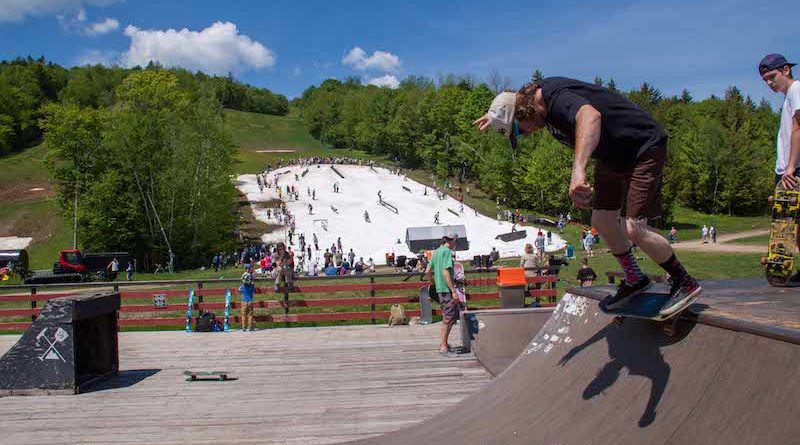What’s Next For Vermont’s Ski Resorts?
When assistant editor Abagael Giles posted on Monday, July 22, that Vail Resorts had offered a cool $264 million to acquire Mount Snow in Wilmington, Vt., as well as Peak Resorts’ 16 other areas, we saw mixed reactions.
[For a look at the key figures in the Peak Resorts acquisition see Mount Snow Went Epic, Here’s What You Should Know]
For some, it was the first time they learned that the Sackler family (the family behind Purdue Pharma, makers of OxyContin) bought enough stock between 2015 and November 2018 to become the majority shareholder in publicly-traded Peak Resorts. The day the sale was announced, the stock price more than doubled.
Others were reminded of the 1996 antitrust suit the state of Maine and Department of Justice brought against Les Otten’s American Skiing Company (then owner of Maine’s Sunday River and Sugarloaf), forcing it to divest two New Hampshire areas when it sought to buy S-K-I, owner of Killington and Mount Snow and four other New England resorts.
As news of the Peak Resorts proposed sale traveled, social media pages lit up with speculation that this latest acquisition by Vail Resorts would mean higher day ticket prices, longer lines and, eventually, price creep on season pass sales.
Others were positive. “Skiing just got cheaper,” wrote one skier on our sister publication, VT Ski + Ride’s Facebook page. An Attitash skier wrote a long post welcoming Vail Resorts and hoping it would invest.
Even the nearby competition welcomed the news. “This will just mean more skiers coming to Vermont and more of a reason for resorts like ours to differentiate ourselves,” said Michael Van Eyck, the chief revenue officer for The Fairbank Group, which operates Bromley Mountain Resort and owns Jiminy Peak in northwest Massachusetts and Cranmore, in New Hampshire.
Since 2017, when Vail Resorts made its first Eastern acquisition (Stowe Mountain Resort), and Alterra bought Stratton, skiing in Vermont has gotten cheaper—for those with season passes. Early season multi-resort pass prices dropped below $1,000, in many cases. And Vermont’s skier days rose to 4.1 million in 2018/19, a near high.
Other good things have happened, thanks to Vail Resorts’ presence. CEO Rob Katz and his wife Alana Amsterdam’s charitable trust has donated more than $100 million to the communities Vail Resorts serves. In December 2018, this included $125,423 to support emotional wellness, distributed via grants by the Vermont Community Foundation.
The three Vermont resorts Vail Resorts now owns have all seen significant upgrades in recent years under prior owners, including the 2018 opening of the new $22 million Carinthia base lodge at Mount Snow.
The question now is how much more the corporate giant will invest in its Vermont ski resorts, our ski towns and local economy.
At a July 23 media day organized by Ski Vermont, Vail Resorts’ representatives talked about a 2019 revamp of the food service—both the restaurants and menus—at Okemo Mountain Resort and a new waffle house at the top of Stowe’s gondola.
At that same event, representatives from other resorts reported on what was going on at their ski areas.
Alterra has invested more than $10 million in Stratton, put in a new lift and built a lift-served mountain bike park that opens this month. Suicide Six’s new mountain bike park, owned by the Woodstock Inn and Resort, is celebrating its first season of downhill lift-served trails. Magic Mountain, independently owned, is installing a new quad chair for this season. Bromley just opened its first 18-hole disc golf course. This month, Killington Resort, owned by POWDR breaks ground on a 58,000-square-foot base lodge. And at a select board meeting in July, Sugarbush representatives spoke of a longer-term plan to build a new hotel.
This comes after a year when Sugarbush and many other resorts saw their most skier/rider visits ever.
Weeks before the Vail Resorts news broke, we received a thoughtful opinion piece from Caleb Magoon, owner of two bike shops in the Waterbury-Morrisville corridor about the potential sale of his home mountain, Jay Peak. It was spurred by the news that 26 interested parties—potential buyers—had signed non-disclosure agreements and were reviewing Jay Peak Resort’s financials. In his open letter to Jay Peak receiver Michael Goldberg, on page 9, Magoon writes: “Jay’s success was in part because people believed management had the local interest and identity of the mountain at heart.”
If Vail Resorts wants to truly help the communities where it operates, it could look at what else it can do for the Deerfield Valley, which has been rocked by the bankruptcy of its other mountain resort, the Hermitage Club.
It could consider working with the Sacklers to offset their financial gains from the Peak Resorts’ sale to help fight the opioid crisis in the communities Peak Resorts has served. And Vail Resorts could do more to support local vendors and brands, such as bringing back Vermont Coffee Company (which it replaced with Starbucks) at its Stowe food service outlets and partnering with other locally-owned Vermont businesses and brands.
What makes skiing or riding or mountain biking the Green Mountain’s resorts so attractive to so many is not necessarily the snow conditions, the ski school or the amenities. It’s the fact that each one of our 20 ski areas is uniquely Vermont.
As Magoon writes in his letter: “Please consider culture and not just cash.”
—The Editors
Featured Photo Caption: Mount Snow’s annual Memorial Day Peace Pipe competition keeps the Carinthia Park rocking until May. Photo courtesy Mount Snow Resort


Pingback: Why Vail Is Buying Mount Snow and 16 Other Ski Areas – VT SKI + RIDE